Marcus Center, Kiley Grove Deemed Historic
Commission decision stalls redevelopment, but allows four ailing trees to be cut down.
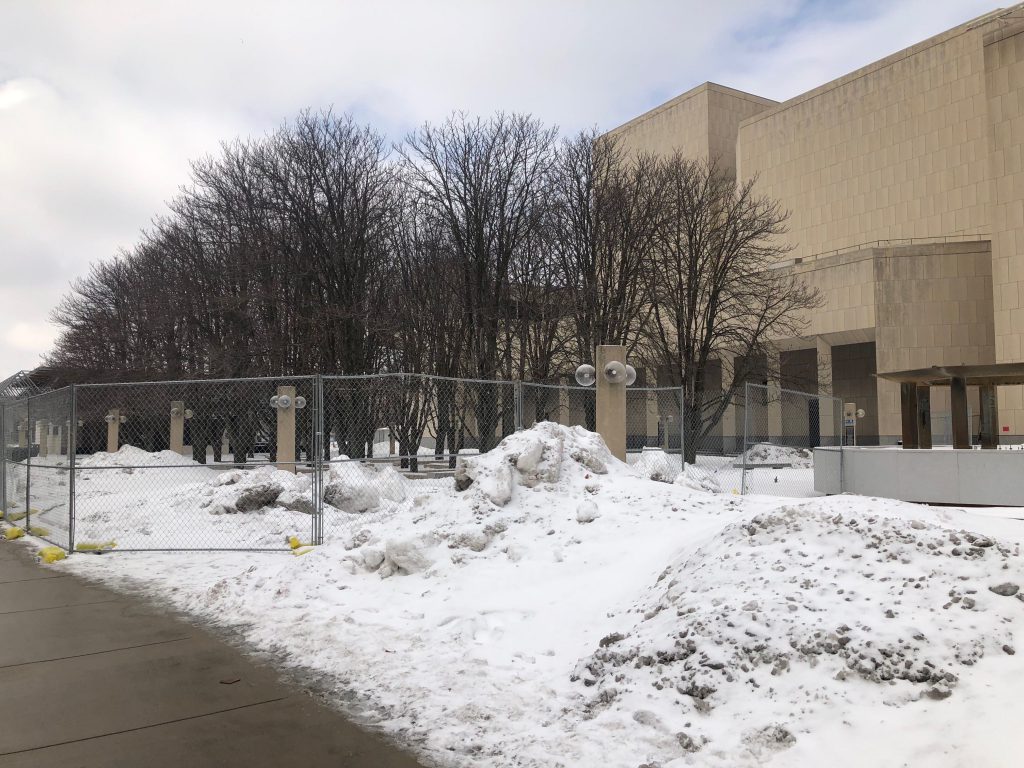
The Kiley grove at the Marcus Center for the Performing Arts. Photo taken February 27th, 2019 by Jeramey Jannene.
The Historic Preservation Commission designated the Marcus Center for the Performing Arts as a historic structure, but also voted to allow the center to cut down four trees in the grove. If the designation stands future changes to the exterior of the complex would require approval from the commission.
The designation decision, which came after two hours of public testimony, will trigger a battle before the Common Council, which could overturn the designation. Paul Mathews, president of the Marcus Center, has vowed to appeal the commission’s decision. Mathews’ organization is seeking to redevelop the complex.
Designed in 1968 by architect Harry Weese, the complex includes a grove of Horse Chestnut trees laid out by landscape architect Dan Kiley. “They thought alike about how buildings and landscapes worked together,” said historic preservation staffer Carlen Hatala in a lengthy presentation espousing the building’s historic merits.
Jennifer Current, landscape architect at Quorum Architects and Mark Debrauske, principal and architect at the Tredo Group, filed an application in January with the commission to have the 3.65-acre property at 929 N. Water St. added to the city’s list of locally-designated historic structures. They were two of eight speakers to support the designation at Monday’s hearing.
The two submitted the nomination in response to news that the center was proposing to replace the Kiley-designed grove with a new landscape plan as part of a broad redevelopment plan.
The non-profit center, which leases the building from Milwaukee County, has surrounded the 36-tree grove with a chain-link fence in response to a study that shows four of the trees are failing. A city arborist confirms that the trees are in poor shape, but disagrees with the center’s consultant on what could be to make them safe in the short run.
“The death of a tree doesn’t equate with the death of a design,” said Current of the organization’s insistence that the grove is in poor health and dangerous. “We are fine with cutting the trees down if they’re that decrepit and dangerous, but they would have to be replaced with the same trees,” said Debrauske.
The Marcus Center relied on testimony from architect Jim Shields, who is guiding the design of the redevelopment, and historian John Vogel in its opposition to the designation. Shields argument against designation centered around the many modifications to the building having demolished the building’s historic integrity. “It seems somewhat far fetched to me that the building maintains it,” said Shields.
Shields singled out two modifications to the building that are key to his belief that the structure lacks historic integrity: the 1994 replacement of the failing marble facade with a mix of limestone and granite and the 1996 addition of a 40-foot deep lobby along N. Water St.
“I have no doubt that if this building still existed in some form as it did originally that it would easily meet your criteria,” concluded Shields. His presentation was a condensed version of one given in February concerning the building’s temporary historic designation.
Vogel gave a presentation centered around the lack of prominence the building and campus receive in publications about Weese and Kiley’s careers. He also said the numerous additions and modifications destroy the building’s historic integrity. “I believe that it must be concluded that the Marcus Center no longer contains its integrity of materials or design,” said Vogel.
Their word choice of “integrity” wasn’t accidental. The city’s preservation ordinance specifies that to be designated a building must “possess integrity of location, design, settings, materials, workmanship and association.”
Three other speakers spoke against the designation in front of a packed meeting room. A number of people submitted letters opposing and supporting the designation.
With no debate after the testimony concluded, Alderman Robert Bauman, made a motion to approve the designation. His motion was seconded by UW-Milwaukee architecture professor Matt Jarosz.
“If it is true that this building is so utterly worthless from a historical or architectural standpoint, as your argument basically says, we should tear that building down and start over,” said Bauman. “You really made the argument that this building is utterly worthless.”
Bauman also took issue with the testimony of two individuals who raised concerns with the designation and its impact on making the grounds compliant with the Americans with Disabilities Act. “Up until the last two speakers, I thought we were having a very productive discussion. Then we have to weaponize accessibility,” said Bauman. He said designated buildings have been routinely modified to comply with accessibility laws.
Jarosz took a different approach. “This needs to be designated, not so much so that we can freeze it in time, but so that there can be input,” said the professor. He concluded that some of the modifications Shields and Vogel were critical of may have been made in a more historically-sensitive fashion if a body like the historic commission could have weighed in.
Ann Pieper Eisenbrown was the sole commissioner to vote against the permanent designation. Patti Keating Kahn and Marion Clendenen-Acosta voted for the designation with Bauman and Jarosz.
Four Trees To Be Cut
The four trees to be cut down were identified by Hoppe Tree Service as at risk of a failure in January. The application had been held at a March meeting so it could be heard following the permanent designation.
“I’m satisfied with taking down the four from a safety perspective,” said Pieper Eisenbrown. Bauman was not present for the second vote, which was approved unanimously by the remaining commission members.
The Marcus Center now has a year to either get the designation overturned or create a landscaping plan the commission finds suitable. If not, it must replace the missing trees next spring.
For more on the issue with the failing trees, see our coverage from March.
Shields’ February Presentation on Center Modifications
If you think stories like this are important, become a member of Urban Milwaukee and help support real independent journalism. Plus you get some cool added benefits, all detailed here.
If you think stories like this are important, become a member of Urban Milwaukee and help support real, independent journalism. Plus you get some cool added benefits.
More about the Marcus Center redevelopment
- Eyes on Milwaukee: Marcus Center Unveils New Grounds - Jeramey Jannene - Nov 14th, 2022
- Eyes on Milwaukee: Marcus Center Starts Construction On Former Chestnut Grove - Jeramey Jannene - May 31st, 2022
- Plats and Parcels: Marcus Center Begins Redevelopment - Jeramey Jannene - Sep 20th, 2020
- Eyes on Milwaukee: Council Says Marcus Center Not Historic - Jeramey Jannene - May 7th, 2019
- Eyes on Milwaukee: Committee Says Marcus Center Isn’t Historic - Jeramey Jannene - Apr 30th, 2019
- Marcus Center Trees Removed Before Permit Issued - Jeramey Jannene - Apr 9th, 2019
- Eyes on Milwaukee: Marcus Center, Kiley Grove Deemed Historic - Jeramey Jannene - Apr 1st, 2019
- Murphy’s Law: Kiley’s Chestnut Grove Provokes Hot Debate - Bruce Murphy - Mar 7th, 2019
- Eyes on Milwaukee: Marcus Center Decision Delayed A Month - Jeramey Jannene - Mar 5th, 2019
- Eyes on Milwaukee: Marcus Center at a Crossroads - Jeramey Jannene - Mar 4th, 2019
Read more about Marcus Center redevelopment here
Political Contributions Tracker
Displaying political contributions between people mentioned in this story. Learn more.
- March 23, 2017 - Robert Bauman received $50 from Ann Pieper Eisenbrown
- March 23, 2017 - Robert Bauman received $250 from Patti Keating Kahn
- March 22, 2017 - Robert Bauman received $100 from Paul Mathews
- May 10, 2016 - Robert Bauman received $250 from Patti Keating Kahn
- February 12, 2016 - Robert Bauman received $50 from Paul Mathews
- November 19, 2015 - Robert Bauman received $100 from Paul Mathews
- March 21, 2015 - Robert Bauman received $100 from Paul Mathews
- September 4, 2014 - Robert Bauman received $50 from Ann Pieper Eisenbrown
Eyes on Milwaukee
-
Church, Cupid Partner On Affordable Housing
 Dec 4th, 2023 by Jeramey Jannene
Dec 4th, 2023 by Jeramey Jannene
-
Downtown Building Sells For Nearly Twice Its Assessed Value
 Nov 12th, 2023 by Jeramey Jannene
Nov 12th, 2023 by Jeramey Jannene
-
Immigration Office Moving To 310W Building
 Oct 25th, 2023 by Jeramey Jannene
Oct 25th, 2023 by Jeramey Jannene


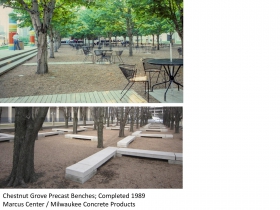
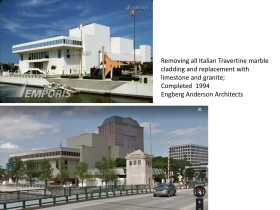
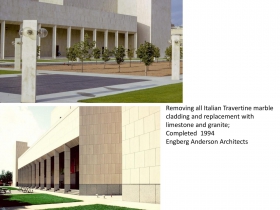
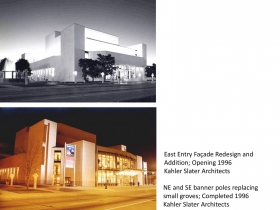
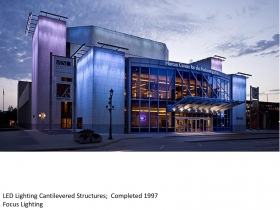
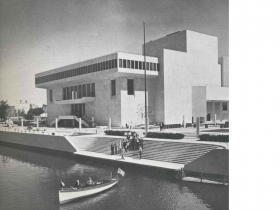




















Hard not to love all the art bunkers built in America in the last half of the 20th century. Conceived, designed, approved, and constructed out of that post-WWII hell-bent on indestructibility. We will have art, dammit, and we will save it from the future! These institutional. artistic-industrial facilities are problematic in a lot of ways. Always have been.
But the chestnut grove was a nice touch from the start. It was an open, free-to-all, public space alongside the brutalist building itself. More like Milwaukee. The trees grow large, old, and fail. And Horse Chestnuts no less. Glorious in spring and summer. The center was born of the best intentions of Milwaukee’s most generous citizens and leaders half a century ago. It’s good enough. It should be preserved as a memorial to what they wanted, trees and all. It’s our wonderful Moulin Rouge. Let’s keep it.
Here’s a first-hand account by someone on Dan Kiley’s design team about the vision behind the Marcus Center’s landscape.
https://www.milwaukeemag.com/thinking-behind-marcus-centers-famous-chestnut-grove/